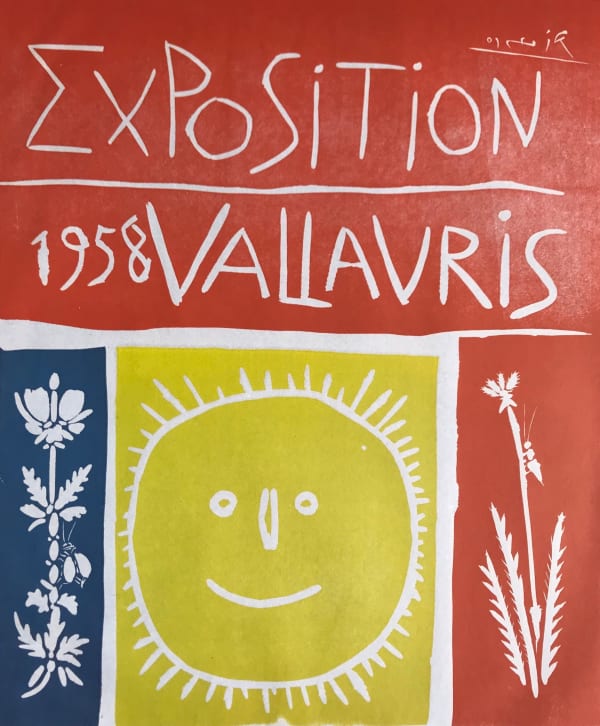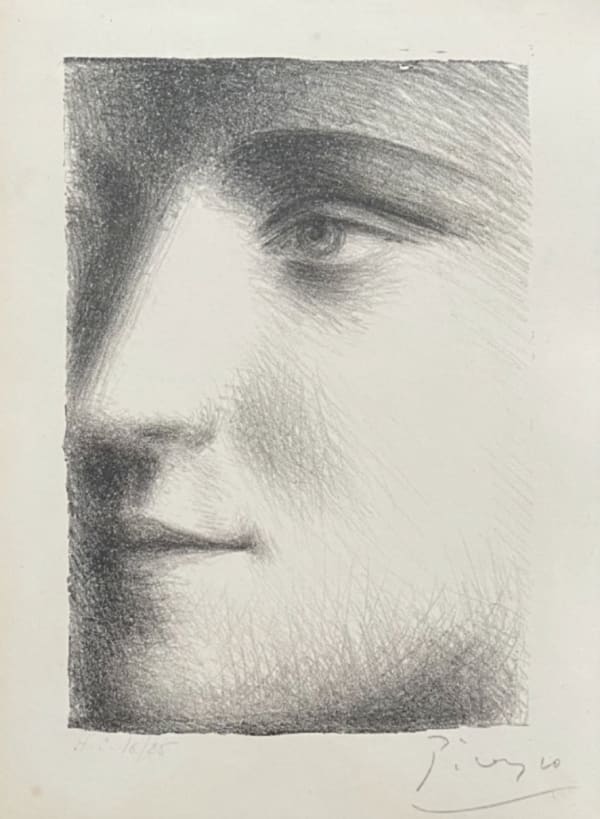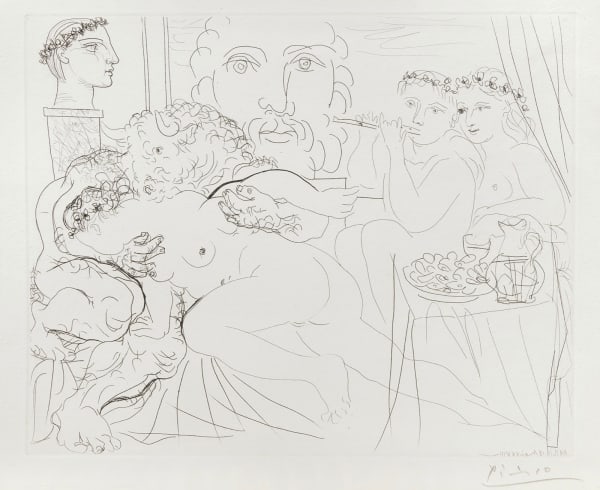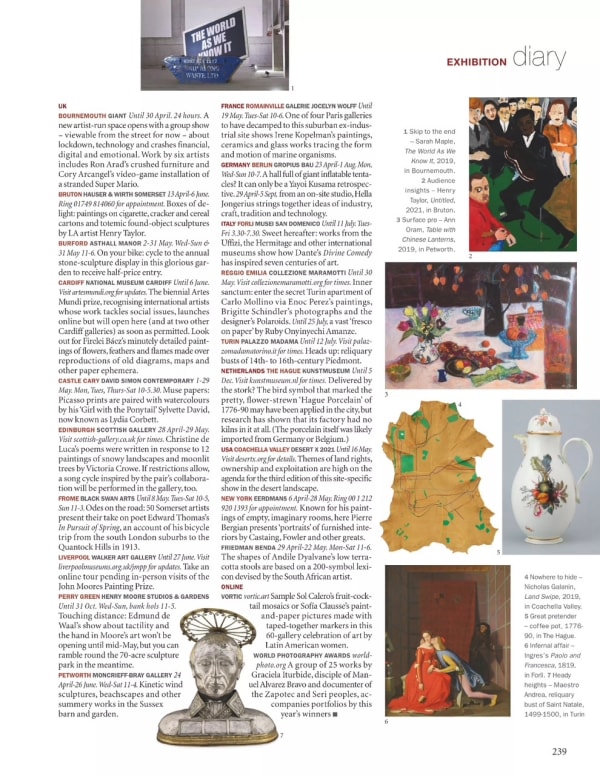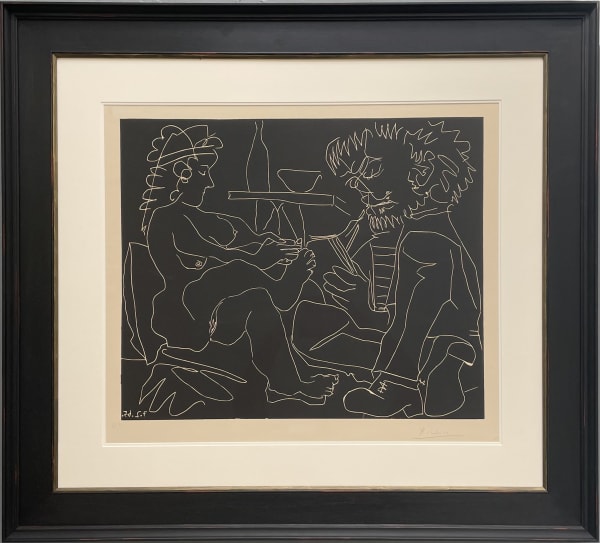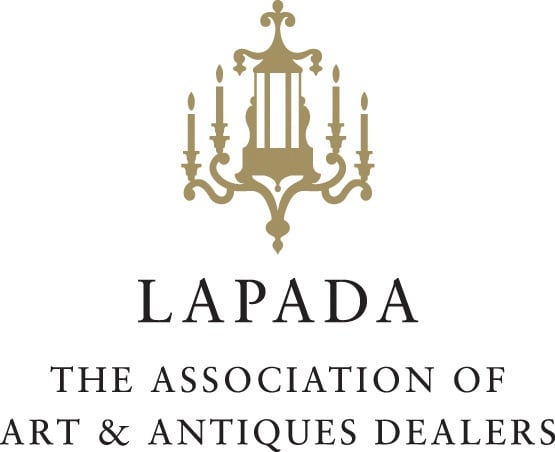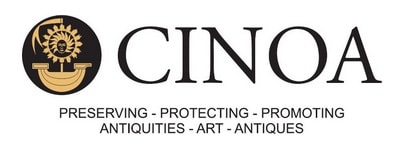Pablo Picasso Spanish, 1881-1973
Pablo Picasso (1881-1973), A School of Paris painter, sculptor, etcher, lithographer, ceramist and designer, who has had enormous influence on 20th Century art and worked in an unprecedented variety of styles.
We hold a good range of original, signed works on paper by Picasso through linocuts, etchings, lithographs and mixed media.
-
 Pablo PicassoPeintre á son Chevalet dans l'atelier III, 1965etching, aquatint and drypoint on Rives paper
Pablo PicassoPeintre á son Chevalet dans l'atelier III, 1965etching, aquatint and drypoint on Rives paper
unsigned proof32.1 x 46.7cm (plate)
37.5 x 48cm (paper) -
 Pablo PicassoPeintre Dessinant et Modéle Nu au Chapeau , 1965original linocut
Pablo PicassoPeintre Dessinant et Modéle Nu au Chapeau , 1965original linocut
Artist's Proof aside from an edition of 16062 x 75cmsigned -
 Pablo PicassoFemme Assise, 1962linocut62.4 x 44.2cmArist's Proof Edition of 50signed
Pablo PicassoFemme Assise, 1962linocut62.4 x 44.2cmArist's Proof Edition of 50signed -
 Pablo PicassoVallauris Exposition, 1958original linocut
Pablo PicassoVallauris Exposition, 1958original linocut
signed in the plate100 x 63cm (paper) 91.5 x 53cm (plate) -
 Pablo PicassoVallauris Exposition 1954 , 1954linocut89.5 x 59cm (paper)
Pablo PicassoVallauris Exposition 1954 , 1954linocut89.5 x 59cm (paper)
69 x 52cm (plate) -
 Pablo PicassoPour Roby (L’Age de Soleil), 1950original etching36.2 x 28.5cm
Pablo PicassoPour Roby (L’Age de Soleil), 1950original etching36.2 x 28.5cm -
 Pablo PicassoInes et son Enfant, 1947original lithograph on Arches paper, second state, edition of 5065 x 50cmsigned
Pablo PicassoInes et son Enfant, 1947original lithograph on Arches paper, second state, edition of 5065 x 50cmsigned -
 Pablo PicassoProfile de femme, 1947lithograph on Arches wove paper
Pablo PicassoProfile de femme, 1947lithograph on Arches wove paper
Printed by Mourlot, Paris56 x 38cmsigned in pencil -
 Pablo PicassoIn the Arena: Young Man Putting the Minotaur to Death, from The Vollard Suite, 1933etching, edition of 260
Pablo PicassoIn the Arena: Young Man Putting the Minotaur to Death, from The Vollard Suite, 1933etching, edition of 260
signedplate: 19.3 x 27cm
sheet: 34 x 44.3cm
Public Collections: MoMA, New York; British Museum, London -
 Pablo PicassoVisage de Marie-Thérèse , 1928original lithograph, edition of 7520.4 x 14.2cm
Pablo PicassoVisage de Marie-Thérèse , 1928original lithograph, edition of 7520.4 x 14.2cm
Public Collections:
Museum of Modern Art, New York (Gift of Mrs John D. Rockerfeller)
National Museum of Modern Art, Tokyo
National Gallery of Canada
signed -
 Pablo PicassoAutoportrait Sous Trois Forms: Peintre Couronné, Sculpteur En Buste Et Minotaure Amoureuxetching, on Montval paper watermark Vollard, with full margins
Pablo PicassoAutoportrait Sous Trois Forms: Peintre Couronné, Sculpteur En Buste Et Minotaure Amoureuxetching, on Montval paper watermark Vollard, with full margins
edition of 260
signed in pencil
Public Collections: MoMA, New York; British Museum, London34.3 × 44.8cm -
 Pablo PicassoLe Peintre et son Modèleoriginal lithograph
Pablo PicassoLe Peintre et son Modèleoriginal lithograph
edition of 50
signed56.5 x 76cm -
 Pablo PicassoModèle nu et Sculpturesoriginal etching, edition of 260, signed
Pablo PicassoModèle nu et Sculpturesoriginal etching, edition of 260, signed
Vollard watermark37.7 x 29.9cm (plate)
45 x 34cm (paper)
Pablo Picasso (1881-1973), A School of Paris painter, sculptor, etcher, lithographer, ceramist and designer, who has had enormous influence on 20th Century art and worked in an unprecedented variety of styles.
The Picasso family moved to Barcelona, when their son Pablo (born in Malaga) entered the School of Fine Arts in 1895. He went on the Madrid Academy in 1897. Early on, Picasso showed great precocity. He first visited Paris in Autumn 1900, then returned in 1901 when he had his first one-man exhibition at the Galerie Vollard. The body of work known as the ‘Blue Period’ paintings of beggars and sad-faced women was begun around this time. Picasso settled in Paris in 1904. In 1905 he painted some pictures of circus folk and embarked on his ‘Rose Period’. Les Demoiselles d’Avignon in 1906-7 marked the beginning of a more revolutionary manner of style, influenced by Cezanne, and African art. Picasso met Braque in 1907 and, with his collaboration, created Cubism. He designed sets and costumes for Parade and other Diaghilev ballets between 1917-24. He also made some neo-classical figure paintings from 1920-4, running parallel to the later Synthetic Cub-ism. Following this, in 1925 he started to make more violently expressive and metamorphic works, and in the subsequent years frequently exhibited with the Surrealists. Picasso created an important series of wrought-iron constructions and modelled sculptures between 1928-34, and made the il-lustrations for Ovid’s Les Métamorphoses, and Buffon’s Histoire Naturelle amongst others. Picasso was awarded First Prize at the 1930 Pittsburgh International. His painting Guernica, 1937 was inspired by the destruction by bombing of the Spanish town of that name. Picasso was invited in to the building housing this work some years later, when the building was under Nazi occupation. When the senior Gestapo officer pointed to Guernica and asked him, ‘Did you do this’, Picasso famously replied, ‘No, you did’. Picasso continued to live in Paris throughout the Occupation.
From 1946 he lived mainly in the South of France at Antibes, Vallauris - where he met Lydia Corbett (née Sylvette David) who modelled for over 60 of his works, Cannes, and from 1958 near Aix-en-Provence, where he maintained a prolific output of paintings, sculptures, etchings, lithographs and ceramics. Picasso died at Mougins, near Cannes.
-

Picasso and his Muse
The World of Interiors, April 1, 2021
-

Pablo Picasso; Lydia Corbett & Alice Corbett: My Life's Inspiration
SOHO.HOME.STUDIO, 6 Duke of York Square, London, SW3 4LY 27 Sep - 8 Oct 2023Pablo Picasso; Lydia Corbett -The Girl with the Ponytail; Alice Corbett ceramicsRead more -

Lydia Corbett & Pablo Picasso
Out of Vallauris 4 - 28 Nov 2022A rare exhibition of paintings, works on paper and ceramics by both Lydia Corbett and Pablo Picasso. Lydia Corbett, née Sylvette David, was the subject of more than sixty paintings...Read more -

The School of Paris
An exhibition of original works on paper by Georges Braque, Marc Chagall, Henri Matisse, Joan Miró and Pablo Picasso 7 - 30 Oct 2021Following a major exhibition of works on paper by Picasso earlier this summer, David Simon Contemporary presents an important collection of original, signed works by these Modern Masters, giving a unique opportunity to acquire museum-quality works throughout October. Exceptional drawings by Marc Chagall, Henri Matisse and Joan Miró are shown with rare, signed original linocuts, lithographs and etchings by Georges Braque, Salvador Dali,Read more
and Pablo Picasso. Alice Corbett, Alice Dallaglio, Lydia Corbett
-
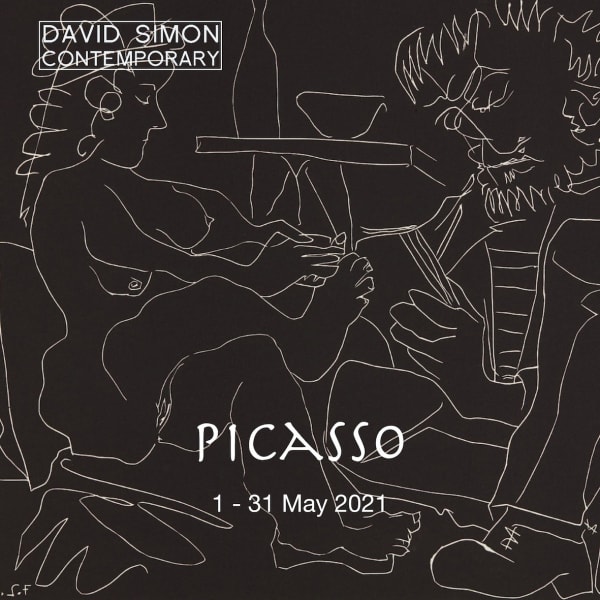
Picasso & Sylvette
David Simon, 2021softback, 50 pagesRead more
Dimensions: 210 x 210mm -
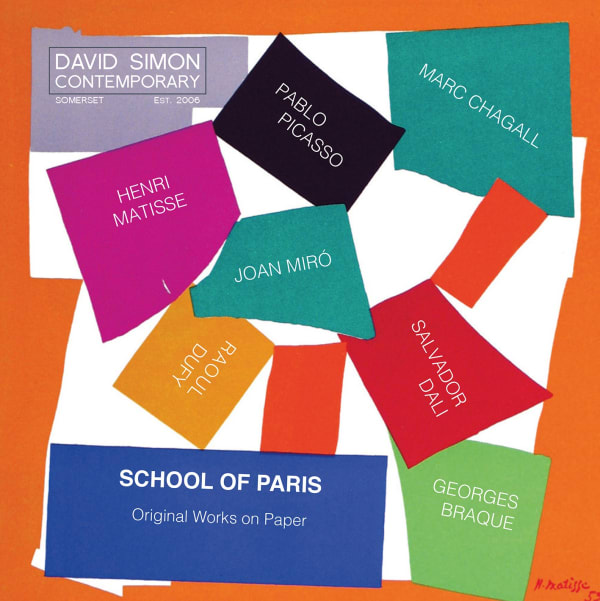
School of Paris
Original works on paper by 20th Century Masters David Simon, 2021Softback, 50 pagesRead more
Dimensions: 210 x 210mm -
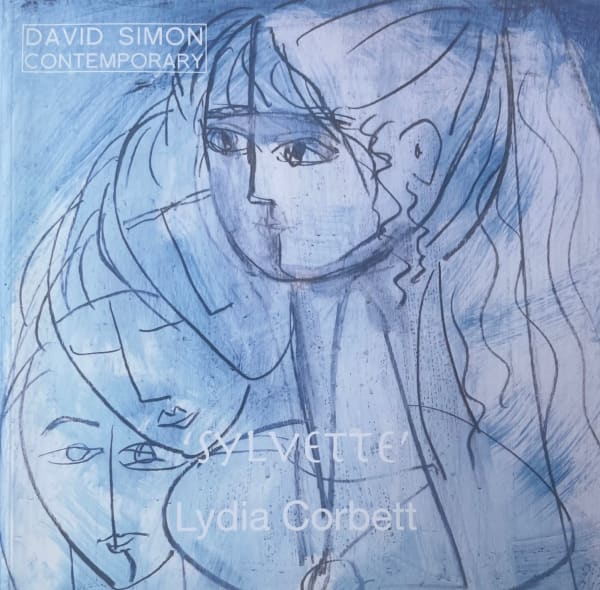
Sylvette
David Simon, 2021softback, 50 pagesRead more
Dimensions: 210 x 210mm





